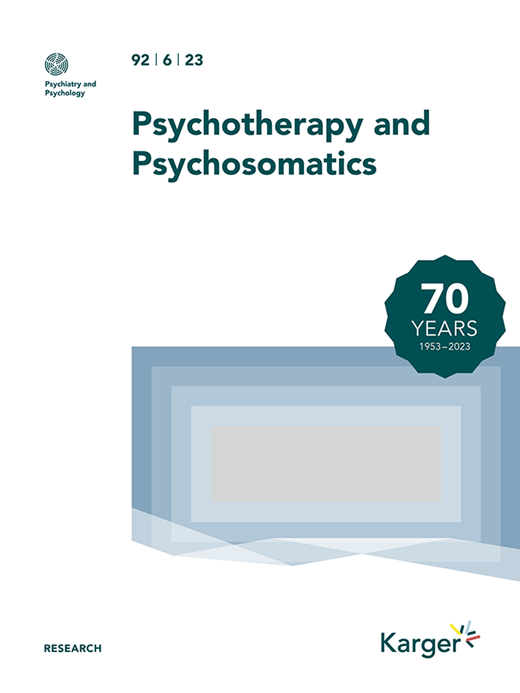Psychopathology in Adults with Co-occurring Avoidant/Restrictive Food Intake Disorder (ARFID) and Higher Weight.
IF 17.4
1区 医学
Q1 PSYCHIATRY
引用次数: 0
Abstract
INTRODUCTION Avoidant/restrictive food intake disorder (ARFID) occurs in individuals across all weight ranges and age groups. While previous studies primarily focused on children and individuals with underweight, research on ARFID in adults with higher weight is virtually non-existent. Therefore, this study aimed to examine whether adults with (1) ARFID symptoms and (2) ARFID diagnosis differ clinically based on weight status (underweight, normal weight, overweight/obesity). METHODS Adults from the population participated in an online survey and optional clinical interview to verify ARFID diagnostic criteria. Data from 369 adults with ARFID symptoms (online survey) and 77 adults with ARFID diagnosis (interview) were analyzed. RESULTS Overweight/obesity was present in 34% of the online (30 ± 9 years, 77% female) and 39% of the interview sample (29 ± 8 years, 62% female). Adults with both ARFID symptoms and ARFID diagnosis and overweight/obesity showed less lack of interest in eating, higher eating disorder psychopathology, and more metabolic comorbidities compared to those with underweight or normal weight. Additionally, adults with ARFID and overweight/obesity exhibited more psychosocial impairment than those with underweight (100% vs. 65%), but no weight loss due to restricted food intake. There were no group differences in terms of food neophobia, smell and texture sensitivities, and depressive symptoms. CONCLUSION This study provides a first detailed analysis of ARFID in adults as a function of weight status, emphasizing its relevance for diagnosis and treatment of ARFID. Future longitudinal studies are needed to explore the role of ARFID in the development and management of higher weight.伴发回避/限制性食物摄入障碍(ARFID)和体重增高的成人精神病理。
回避/限制性食物摄入障碍(ARFID)发生在所有体重范围和年龄组的个体中。虽然以前的研究主要集中在儿童和体重过轻的人身上,但对体重较高的成年人的ARFID研究几乎是不存在的。因此,本研究旨在研究(1)ARFID症状和(2)ARFID诊断是否因体重状况(体重不足、体重正常、超重/肥胖)而有临床差异。方法来自人群的成年人参与在线调查和可选的临床访谈,以验证ARFID诊断标准。分析了369名有ARFID症状的成年人(在线调查)和77名有ARFID诊断的成年人(访谈)的数据。结果34%的在线调查对象(30±9岁,女性77%)和39%的访谈对象(29±8岁,女性62%)存在超重/肥胖。与体重不足或正常体重的成年人相比,同时患有ARFID症状和ARFID诊断以及超重/肥胖的成年人较少表现出对饮食缺乏兴趣,较高的饮食失调精神病理和更多的代谢合并症。此外,ARFID和超重/肥胖的成年人比体重不足的成年人表现出更多的心理社会障碍(100%对65%),但由于限制食物摄入而没有体重减轻。在新食物恐惧症、气味和质地敏感性以及抑郁症状方面,各组之间没有差异。本研究首次详细分析了成人ARFID与体重状况的关系,强调了其与ARFID诊断和治疗的相关性。未来的纵向研究需要探索ARFID在高体重的发展和管理中的作用。
本文章由计算机程序翻译,如有差异,请以英文原文为准。
求助全文
约1分钟内获得全文
求助全文
来源期刊

Psychotherapy and Psychosomatics
医学-精神病学
CiteScore
29.40
自引率
6.10%
发文量
46
期刊介绍:
Psychotherapy and Psychosomatics is a reputable journal that has been published since 1953. Over the years, it has gained recognition for its independence, originality, and methodological rigor. The journal has been at the forefront of research in psychosomatic medicine, psychotherapy research, and psychopharmacology, and has contributed to the development of new lines of research in these areas. It is now ranked among the world's most cited journals in the field.
As the official journal of the International College of Psychosomatic Medicine and the World Federation for Psychotherapy, Psychotherapy and Psychosomatics serves as a platform for discussing current and controversial issues and showcasing innovations in assessment and treatment. It offers a unique forum for cutting-edge thinking at the intersection of medical and behavioral sciences, catering to both practicing clinicians and researchers.
The journal is indexed in various databases and platforms such as PubMed, MEDLINE, Web of Science, Science Citation Index, Social Sciences Citation Index, Science Citation Index Expanded, BIOSIS Previews, Google Scholar, Academic Search, and Health Research Premium Collection, among others.
 求助内容:
求助内容: 应助结果提醒方式:
应助结果提醒方式:


